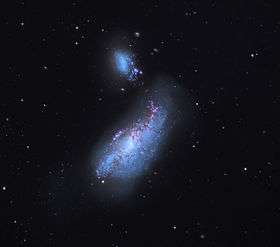NGC 4490
| NGC 4490 | |
|---|---|
 NGC 4490 and its smaller companion NGC 4485. | |
| Observation data (J2000 epoch) | |
| Constellation | Canes Venatici |
| Right ascension | 12h 30m 36.2s[1] |
| Declination | 41° 38′ 38″[1] |
| Redshift | 565 ± 3 km/s[1] |
| Distance | 25.1 ± 5.0 Mly (7.7 ± 1.5 Mpc)[1] |
| Apparent magnitude (V) | 9.8 |
| Characteristics | |
| Type | SB(s)d pec [1] |
| Apparent size (V) | 6′.3 × 3′.1[1] |
| Other designations | |
| Arp 269, UGC 7651, PGC 41333[1] | |
NGC 4490, also known as the Cocoon Galaxy, is a barred spiral galaxy in the constellation Canes Venatici. It lies at a distance of 25 million light years from Earth. It interacts with its smaller companion NGC 4485 and as a result is a starburst galaxy. NGC 4490 and NGC 4485 are collectively known in the Atlas of Peculiar Galaxies as Arp 269. NGC 4490 is located 3/4° northwest of beta Canum Venaticorum and with apparent visual magnitude 9.8, can be observed with 15x100 binoculars.[2] It is a member of Herschel 400 Catalogue. It belongs in Canes Venatici galaxy cloud II.
It was discovered by William Herschel in 1788. Two supernovae have been observed in NGC 4490, SN 1982F, and type II-P SN 2008ax, with peak magnitude 16.1.[3]
Gallery
 Extreme tidal forces have carved out the shapes and properties of NGC 4490.[4]
Extreme tidal forces have carved out the shapes and properties of NGC 4490.[4]
See also
External links
- NGC 4490 on WikiSky: DSS2, SDSS, GALEX, IRAS, Hydrogen α, X-Ray, Astrophoto, Sky Map, Articles and images
- SEDS
References
- 1 2 3 4 5 6 7 "NASA/IPAC Extragalactic Database". Results for NGC 4490. Retrieved 2016-01-18.
- ↑ Craig Crossen, Gerald Rhemann (2012). Sky Vistas: Astronomy for Binoculars and Richest-Field Telescopes. Springer Science+Business Media. p. 233. ISBN 3709106265.
- ↑ List of Supernovae IAU Central Bureau for Astronomical Telegrams. Retrieved 29 December 2015.
- ↑ "Bursting with Starbirth". www.spacetelescope.org. Retrieved 28 September 2017.
Coordinates: ![]()